While we’re all impacted by warmer summers, more frequent flooding, and intensifying storms, the burden of climate change isn’t shared equally. The inequities between green, tree-lined neighborhoods, and those covered in asphalt and surrounded by highways, are exacerbated by climate change, leaving already underinvested neighborhoods to carry the increasing social, health, and economic costs of this crisis.
This inequity isn’t an accident. It is the result of discriminatory policies and inequitable investments that have embedded harm directly into the built environment and the decision-making systems that sustain these injustices. As the climate crisis worsens exponentially each year, communities need immediate solutions to alleviate the impacts of these challenges and improve their day-to-day lives. One of the most challenging parts of environmental justice work is balancing the urgency of mitigating the current effects of environmental harm and the critical need to dismantle discriminatory systems and create long-term systems change to prevent more of the same harm from happening in the future.
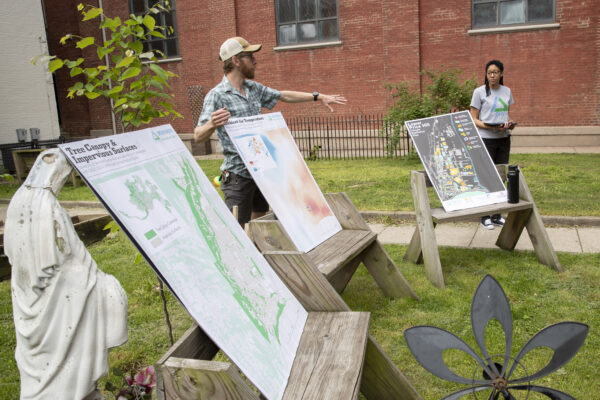
climate safe Cincinnati
Through their Climate Safe Neighborhood (CSN) program, Groundwork Ohio River Valley (GWORV) has been working hard to find this balance between short and long-term action to holistically meet the needs of historically underserved communities across Cincinnati, Ohio.
GWORV runs one of the largest youth workforce development programs in the region. At the heart of all their work is a commitment to engaging young people in transforming their communities into places that are healthy, green, and thriving.
While their youth programs have made significant changes in their community, long-term shifts toward climate justice require intentional collaboration and conversations with stakeholders and partners to determine which climate priorities are most pressing to vulnerable communities and what solutions would be most valuable for residents experiencing climate impacts daily.
To address this gap and progress toward systemic change in the city, GWORV has been collaborating with Cincinnati residents to understand key climate challenges, expanding the use of data visualization tools to advocate for change, and building partnerships with other local community-based organizations through their CSN strategy.
A key component of this strategy is establishing a robust community engagement program. To make that happen, GWORV teamed up with Green Umbrella, a regional climate collaborative, to organize, train, and pay resident advisory groups to help raise awareness about the impact of the climate crisis in the most disproportionately vulnerable Cincinnati neighborhoods and put equity and justice at the top of the agenda for long-term investment. These efforts are helping GWORV pursue short-term and long-term resilience solutions with urgency.
community engagement as a systems change mechanism

Using climate equity indicator data, including a report created by the City of Cincinnati Office of Environment and Sustainability in collaboration with the University of Cincinnati and additional partners, GWORV identified three priority neighborhoods that are more acutely at risk of the impacts of climate change – Lower Price Hill, Bond Hill & Roselawn, and Beekman Corridor – in which to pilot the advisory group model.
Each advisory group had between 7 and 20 community representatives, recruited via outreach to local organizations and town councils, online ads, canvassing, and tabling at recreation centers. Participants went through a 6-8 week intensive training course to learn climate change adaptation and resilience strategies, plan and lead community engagement activities like canvassing and surveying, and engage in the City government’s climate planning process.
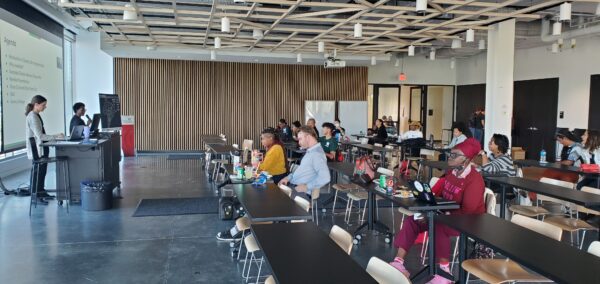
The advisory group sessions focused on a different theme each week, ranging from an introduction to climate change and redlining to green infrastructure. Sessions included interactive mapping activities for residents to determine which areas in their community were especially vulnerable to heat, flooding, and air quality issues and which areas needed climate-resilient strategies to mitigate those issues. In addition, participants administered a survey to their community to collect information about individuals’ experiences with climate change and met with stakeholders and local organizations to learn more about their perspectives. GWORV and Green Umbrella hoped that equity-driven outreach strategies like the climate advisory group model would improve the City’s planning process and lead to long-term change.
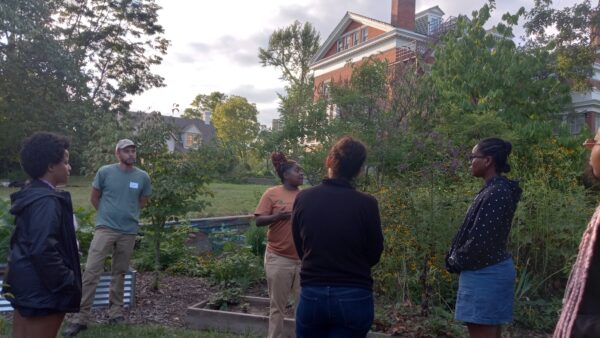
By the end of the intensive, each advisory group created a visionary community resilience statement outlining their collective priorities and guiding their advocacy strategy for long-term change. Beekman Corridor’s community advisory group created this resilience statement:
“Resilience involves the ability to recover and rebound from challenges and setbacks. The challenges are real and impact the Beekman Corridor negatively. Although we have no control over climate-induced threats to our well-being, we must stay informed and develop strategic plans to decrease the harmful effects on our lives. The dream for the Climate Advisory Group is to make our and other communities a better place to live in now and in the future through facilitation and collaboration. We must take steps vitally needed in order to envision this as a reality. It starts on a personal level in our homes, spread throughout the communities, our cities, state and country. In order to have a sustainable planet for future generations.”
Check out GWORV’s CSN Story Maps for more information about the climate advisory groups and their neighborhood climate plans, including examples of their community resilience statements.
reshaping planning & planting
In just two years, the community advisory groups have successfully brought both short and long-term change to Cincinnati.
Tangible improvements to the environment are one notable outcome of the community advisory group’s efforts. As a result of resident advocacy, Lower Price Hill is now on a journey to become Cincinnati’s first Ecodistrict by addressing flooding, urban heat, and air pollution challenges through large-scale land revitalization and green infrastructure projects. GWORV, with the help of volunteers and Cincinnati Parks Staff, planted 70 trees in areas identified by advisory group members as lacking sufficient shade and helped secure funding for 40 more street trees to build out the urban tree canopy. The advisory group’s work has resulted in the neighborhood’s first Green Roof and the revitalization of a parking lot into a small community park. Residents, both youth and adults, were also trained to install air quality sensors across the neighborhood to monitor air pollution levels.
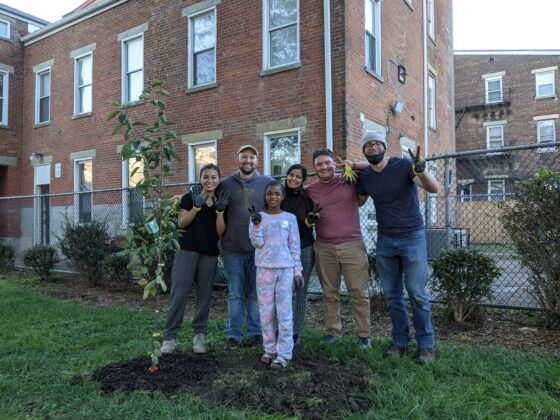
Tree planting event in Lower Price Hill, led by GWORV and the climate advisory group.
In Bond Hill & Roselawn, members of the advisory group and neighborhood leaders hosted local cleanups and administered a survey to understand how to improve food access in their community. They also received a mini-grant to plant more trees in the neighborhood with partners, recently holding a mass tree planting event, and they began a revitalization of the community garden with Cincinnati Parks and volunteers. In the Beekman Corridor, GWORV’s Green Corps, a young adult green workforce, planted 10 trees to provide shade and improve stormwater drainage.
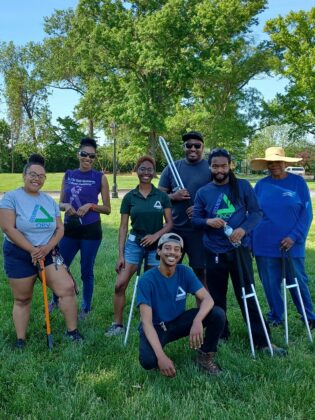
The climate advisory groups have not only improved local conditions for residents, but they have also empowered residents to advocate for the changes they want at the city level, securing several policy wins that will allow them to make municipal systems work for them. Through targeted advocacy, they helped inform the 2023 Green Cincinnati Plan (GCP), the City’s most recent climate action plan. Residents from the groups were tapped to serve as equity liaisons and were paid under Groundwork’s supervision during the GCP deliberation process to ensure community voices were included at the decision-making table. The GCP was approved by the City of Cincinnati, with $700,000 of the $4 million in funding earmarked for equity-focused projects in priority communities, which are often neglected by plans like these. This is a huge shift from the City’s 2018 plan, speaking to the power of resident advocacy in pushing equity-based, community-visioned climate resilience.
Additionally, the advisory groups have helped shift the way the City government carries out its community engagement process and how it develops partnerships to prioritize equity and the needs of community members. The City is taking residents’ concerns seriously, working with GWORV’s resident advisory group leaders to embed additional project ideas into a regional climate action playbook led by Green Umbrella and the Ohio-Kentucky-Indiana Regional Council of Governments. These actions will lead to even more long-term resilience efforts that will benefit residents at a regional scale. The GWORV and Green Umbrella CSN Team is also working with the City to launch a fund to provide grants for the implementation of GCP resilience priorities.
what comes next?
As a result of their successes so far, GWORV will be bringing this climate advisory group structure to more neighborhoods in Cincinnati – two additional groups were created in the Fall of 2023 in Avondale and Norwood – and expanding to the regional level, with plans to kickstart conversations and action toward long-term systems change with partners in Northern Kentucky early 2024.
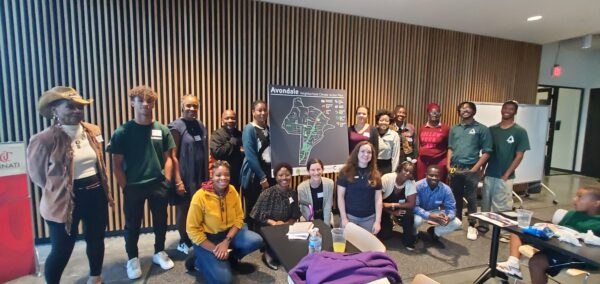
By empowering community members with the tools, knowledge, and skills to advocate for their needs with politicians and decision-makers at the City level, GWORV and Green Umbrella’s climate advisory model is changing the game for climate resilience in Cincinnati. Through sustained advocacy, residents are influencing the status-quo distribution of climate funding to prioritize disadvantaged communities and leading project development and engagement on climate resilience with their neighbors.
To learn more, visit Groundwork Ohio River Valley.
